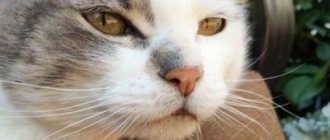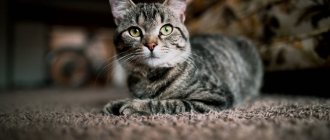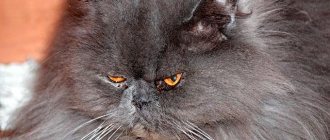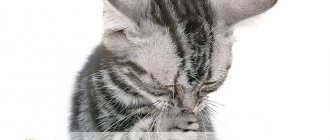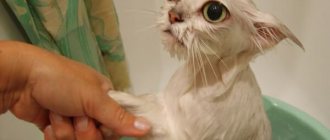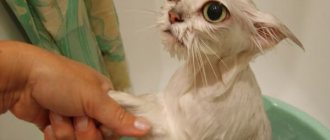Symptoms that something is wrong with your throat
The feeling of a lump in the throat may be accompanied by a “soreness” in the throat, a feeling of incomplete inhalation, difficulty swallowing, discomfort in the neck and chest, a burning sensation or a sensation of a foreign body, although there are no changes when palpated (nothing is enlarged, not deformed, not inflamed).
A “lump” that appears once should not cause concern, since it is most likely a one-time reaction of the body to stress, overwork, or excitement of the nervous system.
If this phenomenon recurs, you should consult a doctor, as this feeling can become a painful symptom, “overgrown” with other manifestations: a feeling of a foreign body in the oropharynx, sleep disturbances, anxiety, loss of appetite and disruption of normal swallowing, surges in blood pressure and sensations of heart failure , diarrhea or constipation.
As a rule, timely and adequate treatment completely eliminates the unpleasant symptom.
Breathing disorders and main respiratory diseases of cats - symptoms
The most common and commonly diagnosed respiratory symptoms are sneezing and coughing. If your cat occasionally coughs, sneezes, or makes strange noises in the throat, monitoring is necessary. Severe or persistent bouts of sneezing or coughing (especially if the cough is wheezing) indicate significant irritation or inflammation in the nasal cavity and lower respiratory tract. Acute bouts of sneezing with discharge from the nose or eyes may indicate a viral infection. Chronically ill cats with upper respiratory disease may stop sneezing, and the main symptom will be nasal congestion.
Cough in cats
Cats have a particularly well developed cough and gag reflex. Tracheobronchial cough can be stimulated by inflammation of the airways, excess mucus production, irritation or pressure inside or outside the trachea, and the development of severe bronchospasm.
Coughing, nausea, or excessive swallowing may occur as the cat tries to clear mucus from the pharyngeal cavity. Cat owners often confuse these symptoms with the phenomenon of regurgitation of hairballs.
Coughing is a common symptom in cats with asthma. However, some cats with respiratory disease experience shortness of breath. Expiratory wheezing is often heard, but there is no cough. Any process that compromises the cat's ventilation and efficient gas exchange will cause changes in its breathing. Minor or intermittent changes may go unnoticed for a long time. For normal breathing, patency is important at all levels of the respiratory system, from the nostrils to the bronchioles.
Airway obstruction in cats
Obstruction of the upper respiratory tract leads to wheezing breathing - inspiratory stridor. Often with long inspiratory time (relative to expiratory time). Stertorous breathing is associated with changes in the proximal upper respiratory tract. In this case, stridor occurs in the larynx area.
If significant airway obstruction develops, the cat will suffer from shortness of breath. Then cyanosis of the mucous membranes can be observed. The animal reduces its breathing rate to allow for a deeper exhalation. This ensures the passage of air through the narrowed airways. You can observe how the cat tenses its peritoneum at the moment of exhalation. When auscultating the lungs at the moment of exhalation, wheezing is detected.
Obstructive pulmonary disease can occur due to changes in the lung parenchyma - for example, fibrosis. In the pleural cavity - for example, the presence of effusion or air. In the chest wall - for example, a rib fracture. Or the neuromuscular system - for example, weakness or dysfunction of the respiratory muscles. Up to a certain point, cats with the pathology do not experience shortness of breath as such, but they breathe more often even at rest.
Rhinosinusitis in cats
Respiratory diseases in cats can have many causes. Upper respiratory tract symptoms (sneezing, wheezing, nasal discharge) often accompany acute viral infection or chronic (idiopathic) rhinosinusitis. Less common causes include nasal neoplasia, fungal rhinitis, periodontal disease, foreign bodies, and nasopharyngeal polyps.
Asthma in cats
Cough is a common symptom in cats with asthma, occurs with varying frequency in cats with lesions of the pleural cavity and lung parenchyma (eg, fibrosis), and is rarely observed in cats with cardiac disease. Cats with cough, especially those with expiratory wheezing, should be evaluated for lower respiratory tract disease.
Other respiratory diseases of cats
Persistent tachypnea indicates restrictive lung disease. Idiopathic pulmonary fibrosis, a recently recognized disease in cats, may also cause clinical signs. Other causes include infiltration of the lung parenchyma (eg, edema), mediastinal changes (eg, thymic lymphoma), and pleural disease.
The reason that the animal is breathing with its mouth open may be severe generalized bronchospasm or pleural effusion. In the first situation, cats often have cyanotic mucous membranes and may experience sinus bradycardia.
Heart disease should always be suspected in cats showing signs of lethargy and tachypnea, but not coughing. Auscultation of the heart can reveal murmurs and arrhythmias, which will be indications for additional studies (electrocardiography and echocardiography). Changes in the right heart with tachypnea may indicate pulmonary hypertension.
Simultaneous manifestations of respiratory and gastrointestinal symptoms may indicate the presence of parasites. Migrations of helminth larvae, according to the latest data, can cause pulmonary pathology, which leads to coughing, shortness of breath, vomiting, and weight loss.
A cough with signs of rhinitis, gastroenteritis or dermatitis may indicate an allergy. Any cat with tachypnea, dyspnea, or respiratory symptoms in combination with other clinical signs (eg, fever or weight loss) should be stabilized and then evaluated promptly. Fecal tests may be needed to detect lung parasites.
Causes of an unpleasant lump in the throat
- Overwork.
- Severe or long-term stress. Nervous tension.
- Neuroses and neurotic reactions.
- Depression.
- Anxiety disorder (phobias, panic attacks, generalized anxiety disorder, etc.)
- Psychosomatic diseases.
- Schizotypal disorder, schizophrenia.
- Consequences of organic damage to the nervous system after trauma. infections, strokes, heart attacks, etc.
- Diseases of internal organs (hyperthyroidism, thyroiditis, tonsillitis, spinal osteochondrosis, hiatal hernia, obesity or cachexia).
- Allergic reactions.
- Poisoning.
Breed predisposition
As a rule, breeds with flattened, short muzzles (brachycephalics) cry most often over bowls due to the structural features of the skull. Similar problems can also occur in representatives of long-haired breeds (obstruction of the tear ducts).
Thus, tearfulness is noted in Persians and their crosses, British and Scottish cats, Sphynx cats and their crosses. For example, the British have blocked tear ducts, but if the cat feels well, there is no reason to worry.
Who to contact if you have a lump in your throat
The feeling of a lump in the throat is treated by a psychotherapist or psychiatrist. During the consultation, the doctor will assess the condition and determine the amount of assistance needed.
Help can be obtained in any clinic where there is a license to provide assistance in psychotherapy, psychiatry and neurology and where a psychiatrist or psychotherapist conducts an appointment.
ROSA Clinic
is a specialized and licensed clinic that provides assistance for all types of disorders accompanied by a feeling of a lump in the throat.
Our specialists
are ready to come to your home for consultation; you can also see a doctor in our clinic.
Treatment is most often carried out at home. If necessary, it is possible to be hospitalized in our own hospital, equipped with modern diagnostic equipment and where it is possible to carry out active treatment.
Other reasons
Watery eyes while eating are most often observed in old cats after 8 years of age, as well as in small kittens due to growth and development of the skull bones. The kitten's eyes often become sour, and if the babies are separated from their mother early, they do not know how to take care of themselves. If the animal feels normal, tears flow only during administration or some time after eating, there is no need to worry.
Poor-quality bowls for drinking and eating can also be called one of the possible causes of increased lacrimation.
Tears while eating can be caused by dust, household chemicals used for washing bowls, hygiene products for animals, poplar fluff, plants, and medicines. It is possible to understand what causes non-food allergies only by eliminating certain factors.
In rare cases, lacrimation is caused by inflammatory processes in the gastrointestinal tract. The cat may experience discomfort and severe pain when eating.
The moisture in the eyes of some cats may increase after sleep, during outdoor games, or physical activity. The more active the animal’s behavior, the more active the lacrimal glands function, as well as metabolism in general.
How is the feeling of a lump in the throat treated?
Treatment is determined by the causes and mechanism of development of the disease and is selected individually for each patient.
For a recent and non-severe condition
treatment is carried out on an outpatient basis: the doctor conducts a psychotherapeutic session, prescribes medications that the patient takes at home and periodically comes for follow-up consultations.
For moderate severity
- treatment in a day hospital is recommended: daily treatment procedures are carried out (drug infusions, physiotherapy, etc.), which take an hour and a half, but the patient lives at home and goes about his usual business. The average course of a day hospital is about 10 days.
In severe condition
hospitalization in a hospital is recommended. Due to intensive treatment, the condition can be stabilized already in the first hours of stay. The average length of hospital stay is 10 days (from 5 to 30 days depending on the severity of the condition and the body’s recovery abilities).
Main methods of treatment:
- Psychotherapy.
- Drug treatment (pharmacotherapy).
- Physiotherapy.
- Massage and manual therapy.
- Diet therapy.
- Biofeedback therapy.
The cat is drooling, is it dangerous?
In itself, increased salivation in a cat is not dangerous for the animal, but this condition causes trouble for both the animal and the owner. A wet face looks untidy, drops of saliva stain the floor, furniture, and leave unsightly marks on the pet’s fur when licked. In severe cases, hypersalivation prevents the pet from eating and drinking; saliva can enter the respiratory tract and cause suffocation.
It rarely gets to severe forms, so it is much more important to know why your cat is drooling. The reason may be trivial and easily removable, and the owner can deal with it on his own.
When to sound the alarm
Warning signs:
- puffiness, swelling of the eyelids;
- redness of the mucous membranes, inflammation of the conjunctiva;
- changes in behavior (drowsiness, depression);
- inadequate reaction to light, photophobia;
- the appearance of a whitish film on the eyes;
- unstable temperature;
- digestive problems;
- corneal clouding;
- formation of crusts on the eyelids;
- frequent blinking, squinting.
Discharge from the eyes can signal not only ophthalmological problems (corneal injuries, entropion of the eyelids, uveitis, keratitis, obstruction of the tear ducts), but also indicate the development of a parasitic, viral, fungal, bacterial infection (rhinitis, otitis, herpes virus infection, chlamydia). Therefore, if you notice any signs of discomfort, do not delay your visit to the veterinarian.
Diagnosis of saliva flow in a cat
When there is a bad odor from the mouth, or there is a protruding tongue with an active flow of saliva , it means that it is necessary to carry out a diagnosis in order to subsequently carry out the correct treatment.
- The veterinarian first examines the oral cavity to identify foreign bodies.
- The second rule is to examine the tongue and teeth for inflammation in the oral cavity, chips, and wounds.
- They do an x-ray and an ultrasound if a foreign object is stuck in the esophagus.
- To determine helminths, a blood and stool test is performed.
- To identify problems with the genitourinary system, a urine test is performed.
General tips on how to help the body cope with illness
For any disease of the respiratory tract, including tracheitis, you should follow some simple rules.
- Drink more warm liquids: fruit drinks and heated mineral water without carbon, decoctions of rose hips, raspberries and linden blossoms. This will not only help relieve intoxication, but will also help thin the sputum.
- Eat high-calorie, vitamin-rich foods. During illness, the body needs nutrients to repair tissue and maintain the functioning of the immune system.
- Stop smoking and ask family members to smoke only outside the home.
- Eliminate irritating factors: smoke, dust, strong odors. During illness, it is advisable not to use household chemicals and temporarily stop using perfumes and eau de toilette.
- Ventilate the room and maintain a sufficient level of humidity. Dry air irritates the mucous membrane of the respiratory tract and provokes coughing attacks.
With timely treatment, tracheitis resolves within 10–14 days, without leaving any consequences and without subsequently limiting the ability to work.
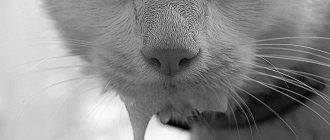
![Why is the cat drooling: [Find out the reason, What to do]](https://koriiza.ru/wp-content/uploads/pochemu-u-kota-tekut-slyuni-uznajte-prichinu-chto-delat-330x140.jpg)

